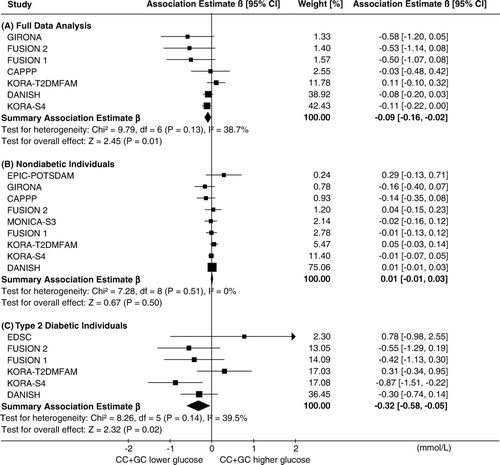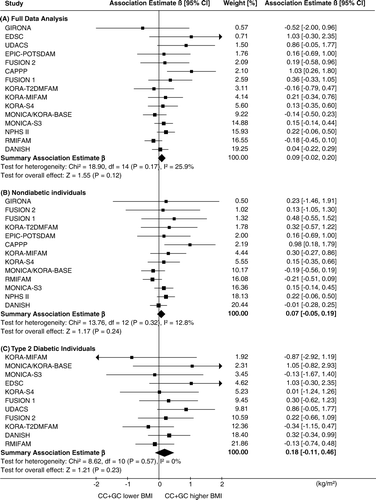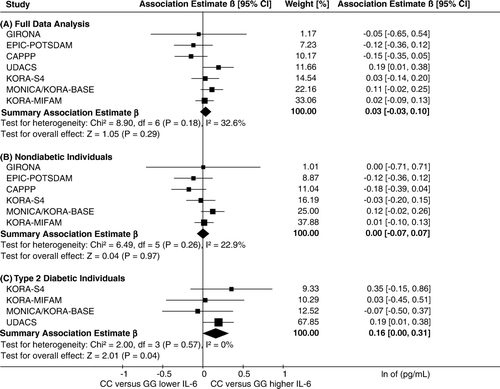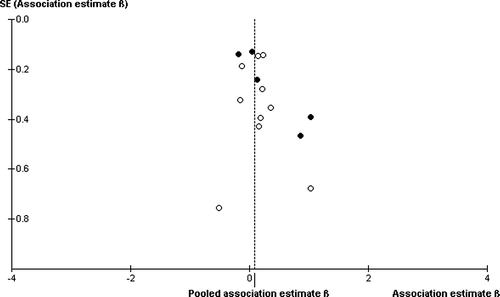Figures & data
Table I. Characteristics of included studies.
Figure 1. Forest plot, illustrating the study-specific β-coefficients with 95% CIs for the association between IL6 -174G>C, dominant model for the C-allele, and fasting glucose in (A) the full data analysis (combined group of non-diabetic and prevalent type 2 diabetes mellitus (T2DM) subjects), (B) only in non-diabetic subjects, and (C) only in prevalent T2DM subjects, adjusted for age, sex, and body mass index (BMI). Additionally, the summary fixed-effect β-coefficient is shown. I2 measures the impact of inconsistency across studies and can range between 0% and 100%.

Table II. Summary results of association between IL6 -174G>C and fasting glucose, 2-h glucose, body mass index (BMI), or interleukin-6 (IL-6) levels. The fixed-effect results are presented for the full data analysisa and for analyses stratified for type 2 diabetes status (T2DM).
Figure 2. Forest plot, illustrating the study-specific β-coefficients with 95% CIs for the association between IL6 -174G>C, dominant model for the C-allele, and body mass index (BMI) of (A) the full data analysis, (B) only non-diabetic subjects, and (C) only prevalent type 2 diabetes mellitus (T2DM) subjects, adjusted for age, sex, and T2DM status (A). Please refer to legend for more details.

Figure 3. Forest plot, illustrating the study-specific β-coefficients with 95% CIs for the association between IL6 -174 CC versus GG and natural logarithm of circulating interleukin-6 (IL-6) levels of (A) the full data analysis, (B) only non-diabetic subjects, and (C) only prevalent type 2 diabetes mellitus (T2DM) subjects, adjusted for age, sex, body mass index (BMI), and T2DM status (A). Please refer to legend for more details.

Figure A-1. (online appendix). Funnel plot for the association between IL6 -174G>C and body mass index (BMI). For each study, the β-coefficient of the dominant model for the C-allele, adjusted for age, sex, and type 2 diabetes status, is plotted against its standard error as a measure of study precision. All studies with IL6 -174G>C genotypes of non-diabetic individuals in Hardy-Weinberg equilibrium (HWE) are included. Black circles represent BMI published studies, white circles represent BMI unpublished studies. The vertical line marks the pooled β-coefficient (0.09 kg/m2).

Table A -I. (online appendix). Methods used for quantifying circulating interleukin (IL)-6 levels and genotyping IL6 -174G>C (rs1800795 according to http://www.ncbi.nlm.nih.gov).
Table A -II. (online appendix). Description of included studies.
Table A -III. (online appendix). References of included studies and overview on analyzed outcomes.
Table A -IV. (online appendix). Overview of studies and numbers of participants included in the analyses of the quantitative traits fasting glucose, 2-h glucose, body mass index, and circulating interleukin (IL)-6 levels.
Table A -V. (online appendix). Characteristics of study participants in the joint analysis.
Table VI. (online appendix). Sensitivity analyses, excluding published studies.a
Table VII. (online appendix). Full data sensitivity analyses, additionally including studies showing Hardy-Weinberg equilibrium (HWE) violation in non-diabetic subjects (C-allele dominant model).